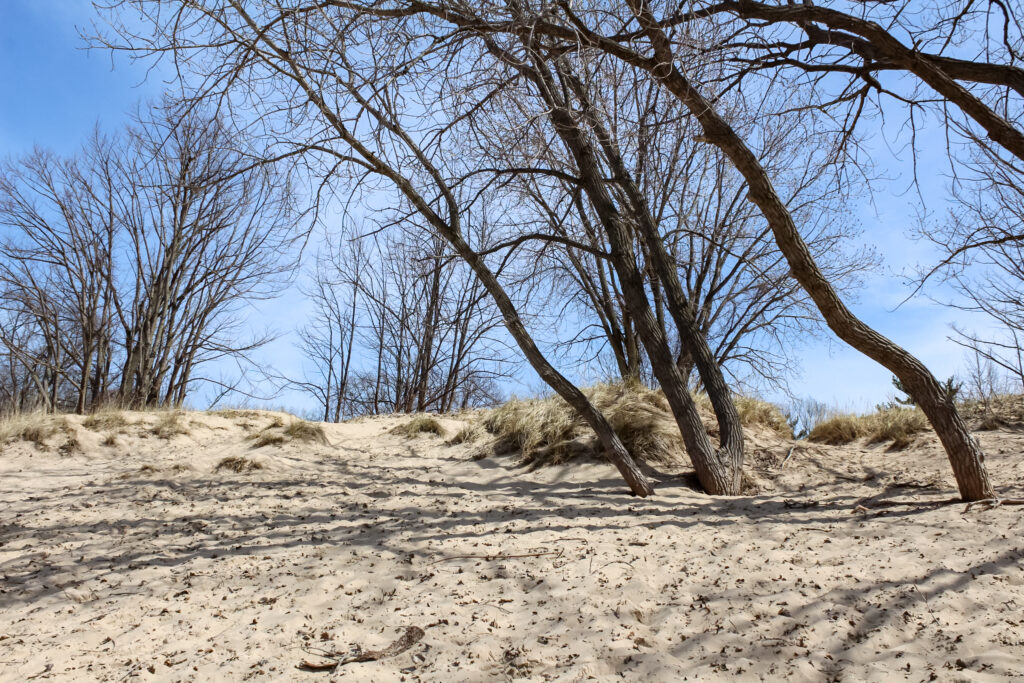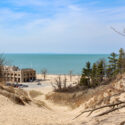Standing at the bottom of a sand dune, the daunting slope of the golden sand glistens in the sun. It’s going to be a challenge to climb, but it’s worth it. Among the grainy sand, small bunches of long grasses reach towards the sky, gently swaying in the wind. The soft sand melts beneath shoes with each step upwards, leaving a small trail of imprints to show how far you’ve climbed.
After the hard trek up, the view of Lake Michigan unfolds. The gentle, brilliant blue water looks endless, the people strolling on the beach below look small. Walking along the dune, it feels like standing on top of the world. You can’t help but admire the beauty on this land.
But all of this almost disappeared – and the fight to save these dunes was an act of perseverance.
Save the Dunes Movement
When traveling by train through Indiana in 1896, Henry Cowles, now known as the father of ecology, became intrigued by the sight of lush bogs and warm colored sand dunes outside the windows. It was unlike anything he had seen before. Cowles decided to get off the train and began studying the unique nature of the sand dunes and the surrounding environment.
“The dunes became his Ph.D. thesis – succession from sand dune to forest, all the changes that you can see plus the different ecosystems all within the dunes area,” said Bill Smith, a park ranger at the Indiana Dunes National Park.
As a strong advocate for the environment, Cowles, along with social worker Thomas Allinson and landscape architect Jens Jensen, later formed the Prairie Club of Chicago in 1908. At the time, sand was being taken from the dunes to make glass. Cowles and his partners wanted to put an end to this. They wanted to protect the land they’d grown to love and preserve it for other people to experience.
But it didn’t last long. Six years after the Prairie Club was formed, World War I put a stop to the club and its movement to establish the Indiana Dunes as a national park. But as the men went off to war, the Women’s Club of Indiana took up the mantle. Member Bess Sheehan had a strong interest in nature and conservation. She was also the chair of the Committee on Forestry and Waterways. She began to advocate for the dunes to become a state park, ultimately succeeding in 1923 with the creation of the Indiana Dunes State Park.
But the story wasn’t over. Roughly 30 years later, Dorothy Richardson Buell decided the dunes deserved more. In 1949, the Indiana resident and her husband, Hal, visited White Dunes National Park in New Mexico. When they returned, they happened to see a poster at a restaurant for the Indiana Dunes Preservation Council. Buell went to the meeting, and it launched a new passion for the 65 year old. She began advocating for adding five extra miles of shoreline to the Indiana Dunes State Park.

By 1952, Buell was dreaming bigger. She created the Save the Dunes Council with a specific agenda.
“She decided to start gathering her female friends who lived in Ogden Dunes, one of the beach communities that’s still there. … She made it very clear that this is not a social group. They were there to work and establish a national park,” said Nancy Moldenhaur, an environmental advocate and the current president of the Save the Dunes Council.
In 1952, the 56-acre Cowles Bog property – named after Henry Cowles – was for sale. Buell decided the members of Council would be the ones to buy it and preserve it. Sold in a county tax sale for $1,730 (nearly $20,000 today), the property was the first purchase the organization made. It was transferred to the Indiana Dunes and became a part of the park.
But while the Save the Dunes Council was beginning to have success, Indiana still wasn’t interested in saving the park. Steel mills were popping up near Lake Michigan’s south shore, particularly near the dunes. Many wanted to destroy the park to make room for more mills.
“Indiana was all about jobs, not dunes,” Moldenhaur said. “And at one point, I saw a picture of people that were gathered together and they had the signs posted, ‘Jobs not dunes.’”
Buell didn’t want to let this happen. She met with Illinois Senator Paul Douglas in 1958 after unsuccessfully lobbying the members of the Indiana Political Establishment to protect the dunes. The two spoke about the bill that would eventually establish the Port of Indiana, an area for ships to bring coal and materials needed to make steel. If established, the port would hurt the environment around the dunes.
Douglas agreed to help Buell. He met with President John F. Kennedy in an attempt to stop the Port of Indiana.
“Paul said, ‘President Kennedy, the dunes are much like the dunes you have at Martha’s Vineyard, and you know how important that recreational space is to you and your family,’” Moldenhaur said. “And that touched Kennedy very deeply in his heart.”
By 1966, the Kennedy Compromise went into effect. It designated the Indiana Dunes a National Lakeshore while also allowing the port to be built between two steel mills situated away from the dunes. As the political figure, much of the credit went to Senator Douglas, but without Buell, it wouldn’t have happened.
“I firmly believe that if there had not been a Dorothy Buell, we would not have an Indiana Dunes National Park now,” Moldenhaur said. “Everything would’ve been bulldozed down.”
But the Save the Dunes Council didn’t stop there. They continued to help expand the land around the dunes, acquiring roughly 14,000 acres of protected nature. The fight to become a national park didn’t end either. In 2019, the Indiana Dunes finally got the title.
“It took a really long time,” Smith said. “When it happened, everybody came in and said, ‘You’re the newest national park.’ And I said ‘Yep, only took us 103 years.’”
The Future of the Indiana Dunes National Park
Fast forward to present day, and the fight isn’t over – it just looks a little different. While it’s a national park now, there are parts of the dunes that were neglected for years. For example: The Dunes Learning Center. It was open until 1976 before being abandoned for 20-odd years. It was finally reopened, but is in desperate need of repairs.
Smith hopes there will be investments in bike trails along the south shore of Lake Michigan or perhaps a bus system to increase access across the park. Most importantly, he wants to continue preservation efforts.
“I want to protect what we have as much as possible,” Smith said.
The same goes for the Save the Dunes Council members. They pride themselves on working collaboratively with other organizations to accomplish their goals of bettering the environment. Currently, they’re developing partnerships to reduce the amount of toxic material that gets dumped into Lake Michigan.
“The Environmental Protection Agency does allow you to dump a certain amount of toxic material into Lake Michigan. So, what can we do together, working with the factory to voluntarily lower those?” Moldenhaur said. “That’s one thing we’re doing. We never had done anything like that before, so I’m very excited about it.”
The council members are also continuing with their preservation work. More recently, they’ve been focused on the Stockwell Woods, a sand dune that has an oak savannah on it. To restore it, they are removing invasive species and trees to help wildflowers and grass grow.
“I love what I do. It’s a privilege to have the role that I have and to play the part I played so far,” Moldenhaur said. “Save the Dunes works with so many different organizations. We don’t do this alone. We couldn’t do it without everybody that’s at the board table.”

